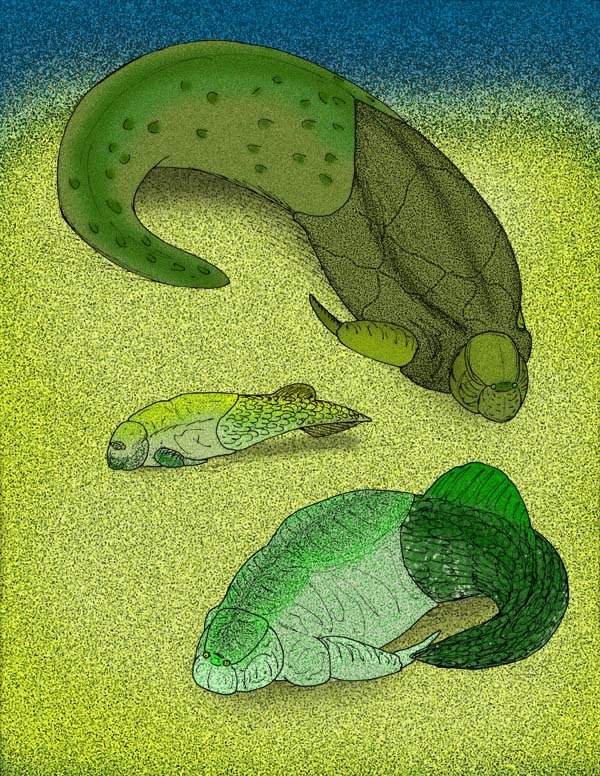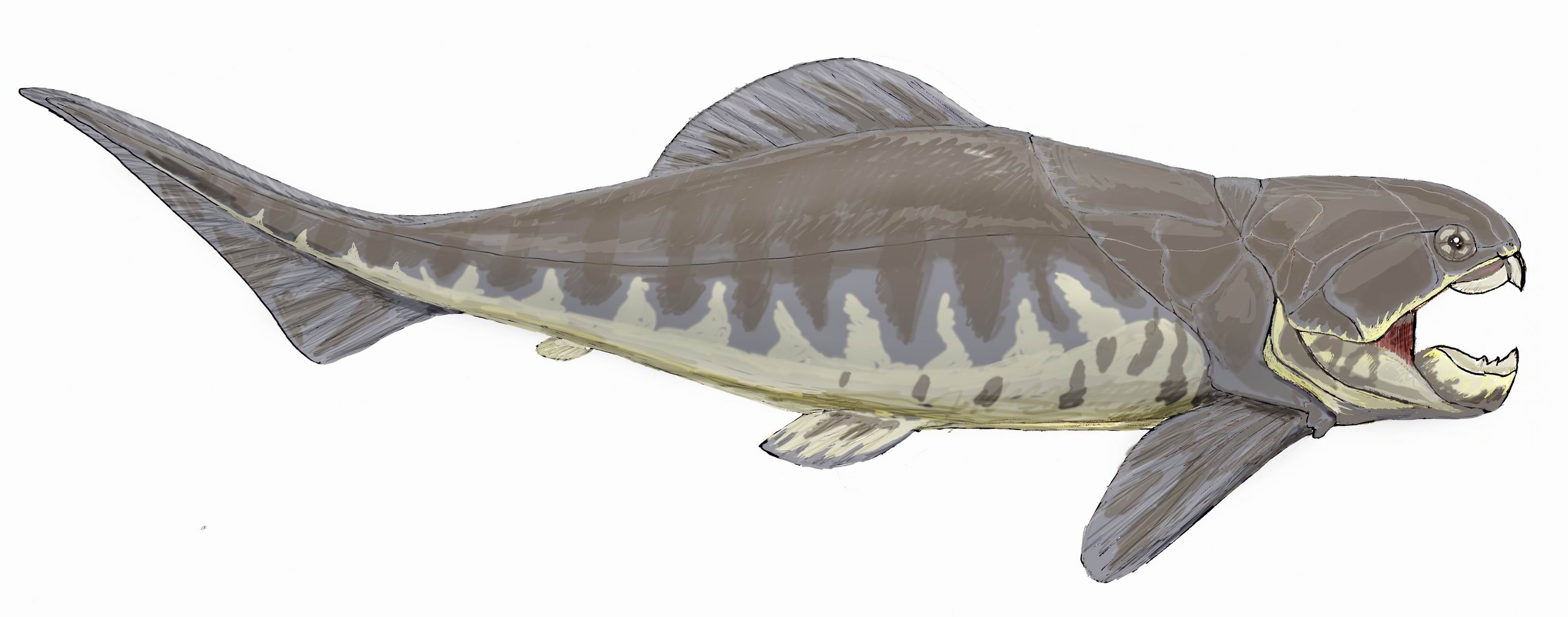|
Parayunnanolepis
''Parayunnanolepis xitunensis'' is an extinct, primitive antiarch placoderm. The fossil specimens, including a marvelously preserved, intact specimen, are known from the Lochkovian Epoch-aged Xitun Formation of Early Devonian Yunnan. The armor is very similar to that of ''Yunnanolepis'', but is distinguished by being comparatively more flattened. An intact and exquisitely preserved specimen demonstrates that the living animal had pelvic fins and a pelvic girdle, thus proving that antiarchs had, primitively at least, pelvic girdles, and or inherited them from a common ancestor of both placoderms and other gnathostome Gnathostomata (; from Greek: (') "jaw" + (') "mouth") are the jawed vertebrates. Gnathostome diversity comprises roughly 60,000 species, which accounts for 99% of all living vertebrates, including humans. In addition to opposing jaws, living ...s. References Placoderm genera Placoderms of Asia Antiarchi Prehistoric animals of China {{placod ... [...More Info...] [...Related Items...] OR: [Wikipedia] [Google] [Baidu] |
Xitun Formation
The Xitun Formation is a palaeontological formation which is named after Xitun village in Qujing, a location in South China. This formation includes many remains of fossilized fish and plants of the Early Devonian period (Late Lochkovian). It was originally referred to as the Xitun Member of the Cuifengshan Formation (now the Cuifengshan Group). Fossil content Vertebrates Acanthodians Actinopterygians Chondrichthyes Jawless fish Placoderms Sarcopterygians Plants See also * List of fossil sites This list of fossil sites is a worldwide list of localities known well for the presence of fossils. Some entries in this list are notable for a single, unique find, while others are notable for the large number of fossils found there. Many of t ...— ''(with link directory)'' References Geologic formations of China Devonian System of Asia Devonian China Devonian northern paleotropical deposits Paleontology in China {{China-geologic-formation-stub ... [...More Info...] [...Related Items...] OR: [Wikipedia] [Google] [Baidu] |
Antiarch
Antiarchi ("opposite anus") is an order of heavily armored placoderms. The antiarchs form the second-most successful group of placoderms after the arthrodires in terms of numbers of species and range of environments. The order's name was coined by Edward Drinker Cope, who, when examining some fossils that he thought were armored tunicates related to '' Chelysoma'', mistakenly thought that the orbital fenestra (i.e., the hole in the headshield for the eyes, nose and pineal foramen) was the opening for the mouth, or oral siphon, and that the opening for the anal siphon was on the other side of the body, as opposed to having both oral and anal siphons together at one end. The front portions of their bodies were heavily armored, to the point of literally resembling a box with eyes, with the sometimes scaled, sometimes naked rear portions often becoming sinuous, particularly with later forms. The pair of pectoral fins were modified into a pair of caliper-like, or arthropod-like ... [...More Info...] [...Related Items...] OR: [Wikipedia] [Google] [Baidu] |
Antiarchi
Antiarchi ("opposite anus") is an order of heavily armored placoderms. The antiarchs form the second-most successful group of placoderms after the arthrodires in terms of numbers of species and range of environments. The order's name was coined by Edward Drinker Cope, who, when examining some fossils that he thought were armored tunicates related to '' Chelysoma'', mistakenly thought that the orbital fenestra (i.e., the hole in the headshield for the eyes, nose and pineal foramen) was the opening for the mouth, or oral siphon, and that the opening for the anal siphon was on the other side of the body, as opposed to having both oral and anal siphons together at one end. The front portions of their bodies were heavily armored, to the point of literally resembling a box with eyes, with the sometimes scaled, sometimes naked rear portions often becoming sinuous, particularly with later forms. The pair of pectoral fins were modified into a pair of caliper-like, or arthropod-like ... [...More Info...] [...Related Items...] OR: [Wikipedia] [Google] [Baidu] |
Early Devonian
The Early Devonian is the first of three epochs comprising the Devonian period, corresponding to the Lower Devonian series. It lasted from and began with the Lochkovian Stage , which was followed by the Pragian from and then by the Emsian, which lasted until the Middle Devonian began, . During this time, the first ammonoids appeared, descending from bactritoid nautiloids. Ammonoids during this time period were simple and differed little from their nautiloid counterparts. These ammonoids belong to the order Agoniatitida, which in later epochs evolved to new ammonoid orders, for example Goniatitida and Clymeniida. This class of cephalopod molluscs would dominate the marine fauna until the beginning of the Mesozoic The Mesozoic Era ( ), also called the Age of Reptiles, the Age of Conifers, and colloquially as the Age of the Dinosaurs is the second-to-last era of Earth's geological history, lasting from about , comprising the Triassic, Jurassic and Cretaceo ... Era. Reference ... [...More Info...] [...Related Items...] OR: [Wikipedia] [Google] [Baidu] |
Lochkovian
The Lochkovian is one of three faunal stages in the Early Devonian Epoch. It lasted from 419.2 ± 3.2 million years ago to 410.8 ± 2.8 million years ago. It marked the beginning of the Devonian Period, and was followed by the Pragian Stage. It is named after the village of Lochkov in the Czech Republic, now part of the city of Prague Prague ( ; cs, Praha ; german: Prag, ; la, Praga) is the capital and largest city in the Czech Republic, and the historical capital of Bohemia. On the Vltava river, Prague is home to about 1.3 million people. The city has a temperate .... The GSSP is located within the Lochkow Formation at the Klonk Section in Prague. In North America the Lochkovian Stage is represented by Gedinnian or Helderbergian time. References Early Devonian {{geochronology-stub ... [...More Info...] [...Related Items...] OR: [Wikipedia] [Google] [Baidu] |
Yunnan
Yunnan , () is a landlocked province in the southwest of the People's Republic of China. The province spans approximately and has a population of 48.3 million (as of 2018). The capital of the province is Kunming. The province borders the Chinese provinces of Guizhou, Sichuan, autonomous regions of Guangxi, and Tibet as well as Southeast Asian countries: Vietnam, Laos, and Myanmar. Yunnan is China's fourth least developed province based on disposable income per capita in 2014. Yunnan is situated in a mountainous area, with high elevations in the northwest and low elevations in the southeast. Most of the population lives in the eastern part of the province. In the west, the altitude can vary from the mountain peaks to river valleys by as much as . Yunnan is rich in natural resources and has the largest diversity of plant life in China. Of the approximately 30,000 species of higher plants in China, Yunnan has perhaps 17,000 or more. Yunnan's reserves of aluminium, lead, ... [...More Info...] [...Related Items...] OR: [Wikipedia] [Google] [Baidu] |
Yunnanolepis
''Yunnanolepis'' is an extinct genus of primitive antiarch placoderm. The fossils of the various species are found in Early to Middle Devonian strata in Southern China ( Xishancun, Lianhuashan and Xitun Formations). External links ''Yunnanolepis''at the Paleobiology Database The Paleobiology Database is an online resource for information on the distribution and classification of fossil animals, plants, and microorganisms. History The Paleobiology Database (PBDB) originated in the NCEAS-funded Phanerozoic Marine Paleo ... Antiarchi Placoderm genera Placoderms of Asia Lochkovian life Fossils of China Paleontology in Yunnan Fossil taxa described in 1963 {{placoderm-stub ... [...More Info...] [...Related Items...] OR: [Wikipedia] [Google] [Baidu] |
Gnathostome
Gnathostomata (; from Greek: (') "jaw" + (') "mouth") are the jawed vertebrates. Gnathostome diversity comprises roughly 60,000 species, which accounts for 99% of all living vertebrates, including humans. In addition to opposing jaws, living gnathostomes have true teeth (a characteristic which has subsequently been lost in some), paired appendages (pectoral and pelvic fins, arms, legs, wings, etc.), the elastomeric protein of elastin, and a horizontal semicircular canal of the inner ear, along with physiological and cellular anatomical characters such as the myelin sheaths of neurons, and an adaptive immune system that has the discrete lymphoid organs of spleen and thymus, and uses V(D)J recombination to create antigen recognition sites, rather than using genetic recombination in the variable lymphocyte receptor gene. It is now assumed that Gnathostomata evolved from ancestors that already possessed a pair of both pectoral and pelvic fins. Until recently these ancestors, kn ... [...More Info...] [...Related Items...] OR: [Wikipedia] [Google] [Baidu] |
Biology Letters
''Biology Letters'' is a peer-reviewed, biological, scientific journal In academic publishing, a scientific journal is a periodical publication intended to further the progress of science, usually by reporting new research. Content Articles in scientific journals are mostly written by active scientists such as s ... published by the Royal Society. It focuses on the rapid publication of short high quality research articles, reviews and opinion pieces across the biological sciences. ''Biology Letters'' has an average turnaround time of twenty four days from submission to a first decision. The editor-in-chief is Professor David Beerling FRS (University of Sheffield) who is supported by an international Editorial Board of practising scientists. Contents and themes As well as the conventional, short research articles, ''Biology Letters'' has recently published Special Features and Mini Series. While Special Features are a collection of up to 20 articles on a specific theme ... [...More Info...] [...Related Items...] OR: [Wikipedia] [Google] [Baidu] |
Placoderms Of Asia
Placodermi (from Greek πλάξ 'plate' and δέρμα 'skin', literally 'plate-skinned') is a class of armoured prehistoric fish, known from fossils, which lived from the Silurian to the end of the Devonian period. Their head and thorax were covered by articulated armoured plates and the rest of the body was scaled or naked, depending on the species. Placoderms were among the first jawed fish; their jaws likely evolved from the first of their gill arches. Placoderms are thought to be paraphyletic, consisting of several distinct outgroups or sister taxa to all living jawed vertebrates, which originated among their ranks. In contrast, one 2016 analysis concluded that placodermi are likely monophyletic, though these analyses have been further dismissed with more transitional taxa between placoderms and modern gnathosthomes, solidifying their paraphyletic status. Placoderms were also the first fish to develop pelvic fins, the precursor to hindlimbs in tetrapods, as well as true t ... [...More Info...] [...Related Items...] OR: [Wikipedia] [Google] [Baidu] |




